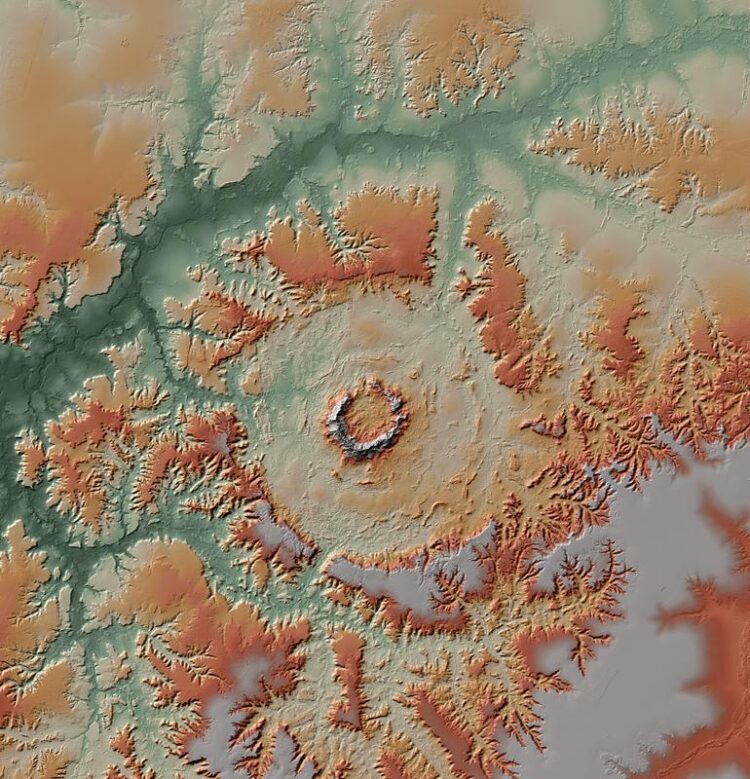The craters on Earth

Physical map of the Serra da Cangalha, Brazil, impact structure, produced using the TanDEM-X mission digital elevation model.
Illustration: Gottwald, Kenkmann, Reimold: Terrestrial Impact Structures, The TanDEM-X Atlas, Verlag Dr. Friedrich Pfeil
A two-volume atlas presents and explains the impact sites of meteorites and asteroids worldwide
Prof. Dr. Thomas Kenkmann, geologist from the University of Freiburg’s Institute of Earth and Environmental Sciences, together with mineralogist Prof. Dr. Wolf Uwe Reimold from the University of Brasilia, Brazil, and Dr. Manfred Gottwald from the German Aerospace Center (DLR) published an atlas providing a comprehensive overview of all known impact craters on every continent. The authors present the more than 200 terrestrial impact sites in high-resolution topographic maps and satellite images, complete with detailed geological descriptions and photographs of the crater structures and their rocks. They also explain the essential details of each impact event.
The formation of craters by asteroid and comet impact has always been a fundamental process in the solar system, explains Kenkmann. As the planets developed along with their moons, these impacts played an important part in accreting planetary mass, shaping the surfaces of planetary bodies, and later also influencing their development. And larger meteorite impacts eventually affected the development of life on Earth.
Today, mapping of what can still be seen of the impact structures on the Earth’s surface can be done by satellites in low Earth orbit. From 2010 to 2016, the DLR successfully measured the Earth’s surface with the radar satellites of the TanDEM-X mission. The acquired data allowed, for the first time, to derive a worldwide terrain model with a height accuracy of up to one meter. From this global digital elevation model the authors have been able to produce this complete topographic atlas of 600 pages with information about all terrestrial impact craters known to date.
Original publication:
Gottwald, M., Kenkmann, T., Reimold, W. U. (2020): Terrestrial Impact Structures. The TanDEM-X Atlas. Part 1 and 2. Munich.
Contact:
Prof. Dr. Thomas Kenkmann
Institute of Earth and Environmental Sciences
University of Freiburg
Tel.: +49 761 203 6495
thomas.kenkmann@geologie.uni-freiburg.de
Originalpublikation:
https://www.pr.uni-freiburg.de/pm-en/press-releases-2020/the-craters-on-earth?se…
Media Contact
All latest news from the category: Earth Sciences
Earth Sciences (also referred to as Geosciences), which deals with basic issues surrounding our planet, plays a vital role in the area of energy and raw materials supply.
Earth Sciences comprises subjects such as geology, geography, geological informatics, paleontology, mineralogy, petrography, crystallography, geophysics, geodesy, glaciology, cartography, photogrammetry, meteorology and seismology, early-warning systems, earthquake research and polar research.
Newest articles

A blueprint for mapping melting ice sheets
Researchers in the Stanford Radio Glaciology lab use radio waves to understand rapidly changing ice sheets and their contributions to global sea-level rise. This technique has revealed groundwater beneath Greenland,…

Water hyacinth plant pots – utilization of an invasive species
Together with Fiber Engineering GmbH, the DITF presents a process for the production of biodegradable plant pots. The products are cost effective and competitive. At the same time, the production…

Current research on the new 6G mobile communications standard
Nursing care robots, autonomous driving, digital twins: all of these high-tech applications will play an essential role for the new 6G mobile communications standard. The first commercial 6G networks are…



